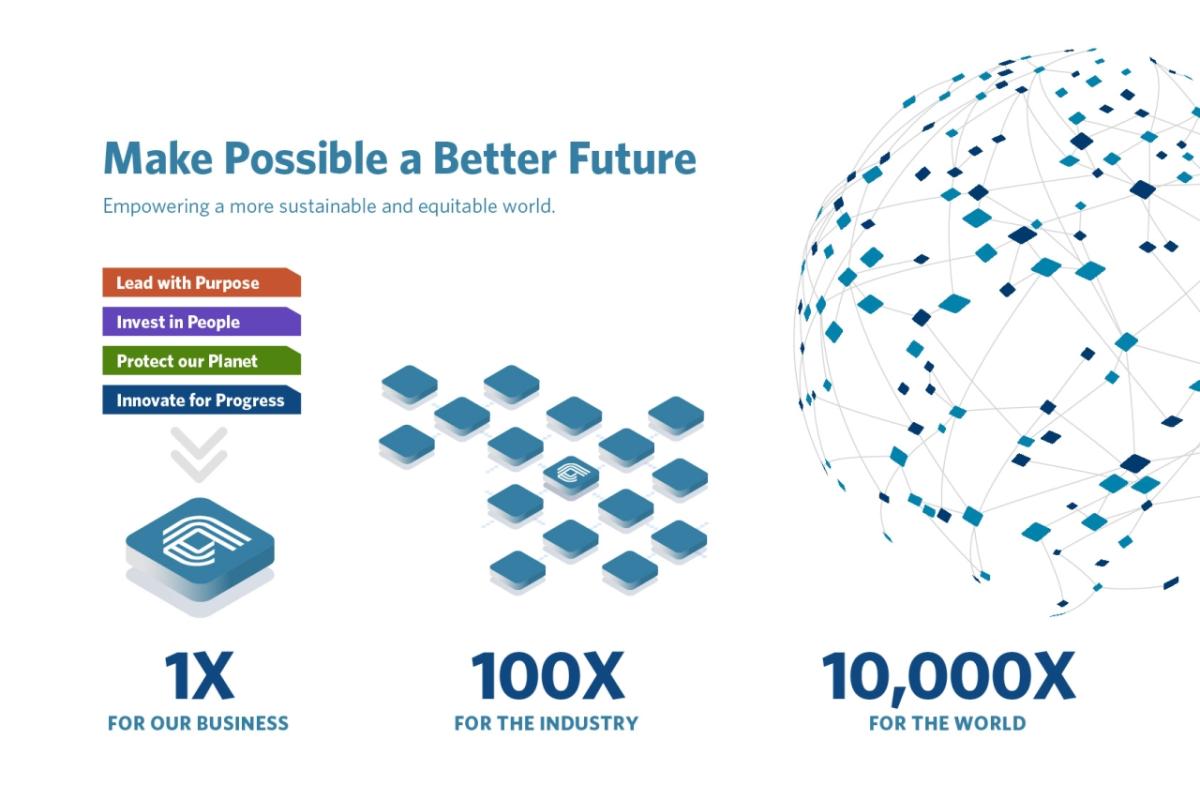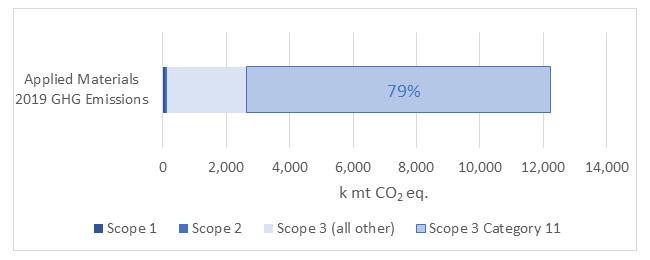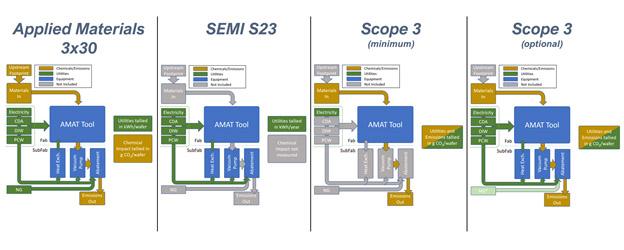Greater Collaboration and Transparency in Reporting Are Key to a More Sustainable Semiconductor Industry
The threat posed by climate change is motivating efforts around the world to improve corporate sustainability, reduce greenhouse gas (GHG) emissions and limit global temperature rise to 1.5°C under the Paris Agreement. According to The Conference Board, 71% of S&P 500 companies publicly report GHG emissions.[1] In recent years, the semiconductor manufacturing industry has become recognized as a major and growing contributor to GHG emissions,[2],[3] which is prompting companies in the industry to declare GHG emissions reduction targets and timelines for achieving net zero emissions. These targets can only be achieved through transparency, cooperation and information sharing; however, there is no universal standard for capturing the relevant metrics. The widely adopted Greenhouse Gas Protocol (GHG Protocol) is flexible by design, allowing users to tailor metrics to meet their specific business needs. It bears mentioning that because of this flexibility, GHG Protocol guidelines explicitly state the Scope 3 Protocol is not intended to allow comparison of different companies’ metrics. Given this limitation, there is a need for transparency in how GHG inventories are calculated to give context to stakeholders and enable corporate accountability. This paper provides an overview of the approach Applied Materials takes for a key part of its GHG reporting and its 3x30 initiative’s role in the analysis.
Tracking Sustainability at Applied Materials
Applied’s 1x – 100x – 10,000x sustainability framework characterizes the environmental impact of its operations, the use of its products, and the products it enables. As part of Applied’s vision to Make Possible® a Better Future, this framework reflects Applied’s view that the company can find outsized environmental benefits if it looks beyond its factory gates for opportunities to reduce GHG emissions.
As is the case with many equipment manufacturers, GHG emissions from the use of Applied’s products dwarf the direct emissions from its own operations. By designing more efficient products, Applied can extend its sphere of influence to fulfil its commitment to reduce its environmental impact. To this end, in 2020 Applied launched the 3x30 initiative (part of 100x) with three targets for Applied’s products to reach by the year 2030: (1) a 30% reduction in equivalent energy use, (2) a 30% reduction in the impact of chemical use and (3) a 30% reduction in required cleanroom floorspace.
These three targets are measured on a per wafer basis as averaged across Applied’s fleet of products. The metrics used to track progress toward these 3x30 goals incorporate existing standards where appropriate and are compatible with global reporting structures such as the GHG Protocol. The proprietary system-level modeling approach that serves as the main information gathering tool for 3x30 gives Applied a detailed look into product use-phase emissions and allows for a comprehensive summation of the bulk of Applied’s reported GHG emissions.[4]
GHG Protocol and Scope 3
The GHG Protocol, a joint endeavor of the World Resources Institute and the World Business Council for Sustainable Development, is a widely used accounting standard for corporate greenhouse gas emissions. [5] The GHG Protocol assigns GHG emissions to one of three groups: Scope 1 – direct GHG emissions from company-owned or -controlled facilities (such as factories, offices, and vehicles); Scope 2 – indirect emissions from the purchased electrical or heat energy used to power company-owned facilities; and Scope 3 – indirect emissions from a company’s value chain not captured in Scope 1 or 2.
Scope 1 and 2 are relatively straightforward to inventory given their narrow definitions and the control a company has over these emissions sources. The more complicated Scope 3 is split into 15 categories, capturing emissions sources spanning a company’s supply chain and its customers’ activities.
Customer use of Applied’s products over their estimated lifetime (Scope 3, Category 11) comprises nearly 80% of Applied’s reported GHG emissions (see Fig. 2). Given the impact of this one category and that Scope 3 analyses require a variety of assumptions and judgements, credibility requires sharing the assessment details of this inventory. Applied’s Scope 3 Category 11 inventory includes the following assumptions:
- Energy and chemical use are modeled using proprietary software for a toolset that represents the company’s portfolio average.
- 1 kWh of electricity use equates to 485g CO2 emissions (estimated global average)
- Estimated average product life is 10 years.
- Utilities (including N2, ultrapure water, compressed dry air, exhaust and cooling water) are included by way of the SEMI S23 [6] standard for converting utilities to “equivalent energy.”
- Emissions from natural gas burned in point-of-use abatement systems are included.
- Estimated equipment operation follows the SEMI S23 standard estimate for equipment availability in a production environment (i.e., 75% Process / 20% Free Time / 5% down time).
- Energy/utility demand from all required sub-fab equipment is included.
Modeling
Semiconductor manufacturing tool configurations and wafer process recipes are tailored solutions unique to each customer. In order to avoid the use of sensitive customer information, Applied designates a select mix of tools and models their energy and chemical consumption with its proprietary software which simulates running BKM/middle-of-the-road recipes. These models collectively approximate the fleet average of the tools deployed in the field. These representative data scale with sales information to provide a complete estimate of the product fleet emissions. A team of sustainability engineers works in concert with the product engineering teams to model these representative tools and processes in detail, to provide a baseline against which we measure progress toward our 3x30 goals. The output of these models also provides the estimated emissions under Scope 3 Category 11.
Lifetime
Product lifetime is the single biggest variable in defining Scope 3 Category 11. Longer product life is generally a positive attribute for any capital good; but in a seemingly contradictory fashion, it also results in a larger Scope 3 contribution. For example, if Applied assumed a 20-year product life instead of 10, the Scope 3 Category 11 emissions total would double under the GHG Protocol. Also typical for capital assets, extensive refurbishment or modification of semiconductor manufacturing equipment is encouraged to extend its useful life. The resulting system however often resembles a completely different tool running a completely different process. Because of these functional changes and the fact that the tool OEM often does not handle the refurbishment, Applied does not consider the post-refurbishment “second life” as part of its own products’ Scope 3 lifetime. Although most Applied tools that entered production 10 years ago (or even longer) are still in operation, a review of sales and service data shows 10 years to be a useful approximation for a tool’s lifespan prior to refurbishment or major modification.
Including the Sub-Fab
All semiconductor manufacturing equipment relies on third-party support equipment such as vacuum pumps, heat-exchangers and point-of-use abatement systems that often reside outside of the cleanroom in an area known as the “sub-fab.” The GHG Protocol does not give specific instructions for the semiconductor manufacturing industry on how to handle sub-fab equipment, but it describes indirect use-phase emissions as “optional” to include (See Fig. 3). Applied takes the position that sub-fab equipment should be included in its inventories because they are only in use to support the Applied systems, and those systems cannot work without the sub-fab equipment. The design of Applied products influences how this support equipment operates, and because of that influence, Applied has a responsibility to account for those emissions. Along these lines, Applied’s iSystem™ product can reduce total fab energy use through optimized use of the sub-fab equipment’s idle or low-power modes.
Utilities and SEMI S23
In addition to process chamber emissions and direct electricity consumption, semiconductor fabs provide utilities, including cooling water, vacuum, ultra-pure water and pressurized clean-dry-air, all of which need energy to deliver and thus can contribute to GHG emissions. Companies across the semiconductor industry recognize the SEMI organization’s S23 Guidelines as the benchmark standard for estimating the energy needed to prepare and deliver these utilities. Converting utility usage into their equivalent energy values helps to highlight opportunities and incentivizes manufacturers to reduce energy use across a fab. For example, if an engineer can enable a tool to require less cooling water, then the fab will consume less energy by avoiding the need to cool the water.
Chemical Emissions
Semiconductor wafer processing often requires chemicals that are high global-warming-potential (GWP) GHGs, including most notably, fluorine-containing hydrocarbons that can be thousands of times more potent than carbon dioxide in their contribution to climate change. The chemical properties of these materials are vital to wafer processing, and in many applications in a fab there are no ideal substitutes available (wafer etching and chamber cleaning, to name a few).
Fortunately, the reactions the materials undergo in wafer processing can result in a large portion of the GHG’s being eliminated, and point-of-use abatement systems are a standard means to destruct much of the remaining high-GWP emissions (often >95%). Applied includes its own post-process chamber emissions data and assumes IPCC default destruction and removal efficiencies (DRE) [7] for abatement in its Scope 3 calculations (see Fig. 4) to accurately model the GHG emissions.
When appropriate, Applied also includes natural gas burned in point-of-use abatement systems, a utility which is not currently included in the S23 Guidelines (see Fig. 3). The remaining post-abatement emissions convert to mass-equivalent CO2 based on the IPCC AR5 GWP100 values [8] and add to the Scope 3 Category 11 total. This approach provides a complete view of the GHG emissions coming directly from the tool (these emissions also contribute to the Scope 1 emissions of the chipmaker).
Several materials commonly used in semiconductor manufacturing have a zero global warming potential, but still have an impact on the environment and should be considered in efforts to improve sustainability. Vapor deposited metals which are mined, refined, and smelted; helium which is extracted from natural gas mining and liquified under intense pressure; silane; and TEOS are all examples of materials consumed in wafer processing with no GWP, and that therefore do not appear in Applied’s Scope 3 Category 11 emissions, consistent with GHG Protocol guidelines.
The 3x30 initiative’s metrics include upstream life-cycle-inventory (LCI) data for the input materials to wafer processing, so they do not go unaccounted for by Applied (GHG Protocol captures these emissions in the Scope 3 Category 1 of the chipmaker, but not the equipment maker). Including upstream LCI in Applied’s 3x30 metrics helps to steer process development toward using less material, lower-impact materials, or both, and supports our customers’ efforts toward their own sustainability goals.
What This Means to the Industry
Clear and complete reporting of GHG emissions ensures accountability and helps meaningfully connect actions to results. Guidelines like the GHG Protocol and S23 provide general-purpose frameworks that all semiconductor companies can use and are vital to tracking progress towards a more sustainable industry. Alternatively, sector-specific frameworks like Applied’s 3x30 can be a better option for companies to drive their own business and sustainability goals. In all cases, transparency is key to giving credibility to any reported result, whether using a general standard or a more bespoke reporting structure.
To ensure completeness in its accounting, Applied is taking an all-of-the-above approach, using existing standards where available, transparency whenever possible, and developing its own metrics when needed. Despite the variability inherent to Scope 3 accounting, it remains a powerful tool for understanding one’s own indirect emissions that can have outsized impact on a company’s overall footprint, and thus is key to any meaningful efforts to address climate change. Manufacturers should be incentivized to influence the users of their products to reduce energy use and emissions wherever possible, which is what Scope 3 accounting is all about.
As chipmakers move to renewable energy, their Scope 2 emissions and Applied’s Scope 3 Category 11 emissions will drop. While it makes sense to acknowledge the changing energy landscape, Applied is not relying on this trend to achieve its sustainability goals. More widely available renewable energy will not preclude the need for the industry as a whole to use energy responsibly and look for ways to grow while reducing net energy usage. By setting the 3x30 energy reduction goals in kWh rather than CO2eq, Applied directly links its sustainability goals with its customers’ efforts to reduce emissions.
Applied can make its products more efficient, but ultimately it must collaborate with its customers and industry partners to affect large-scale change and enable the achievement of ambitions like net zero targets. Information sharing (and transparency around metrics) will be key to accurate reporting, and many solutions will require co-development between material suppliers, equipment makers and chipmakers. Through such collaboration and transparency Applied is committed to deliver on its promise to Make Possible® a Better Future.
[1] https://www.prnewswire.com/news-releases/report-stark-gap-in-climate-disclosures-exists-between-large--small-public-companies-301465038.html
[2] https://www.bloomberg.com/news/articles/2021-04-08/the-chip-industry-has-a-problem-with-its-giant-carbon-footprint
[3] Proceedings - International Symposium on High-Performance Computer Architecture, 2021-February, 854-867; https://asu.pure.elsevier.com/en/publications/chasing-carbon-the-elusive-environmental-footprint-of-computing
[4] https://www.appliedmaterials.com/us/en/blog/blog-posts/adding-sustainability-to-the-definition-of-fab-performance.html
[5] https://ghgprotocol.org/
[6] https://store-us.semi.org/products/s02300-semi-s23-guide-for-conservation-of-energy-utilities-and-materials-used-by-semiconductor-manufacturing-equipment
[7] 2019 Refinement to the 2006 IPCC Guidelines for National Greenhouse Gas Inventories, 6.58, Table 6.17
[8] https://www.ghgprotocol.org/sites/default/files/ghgp/Global-Warming-Potential-Values%20%28Feb%2016%202016%29_1.pdf






